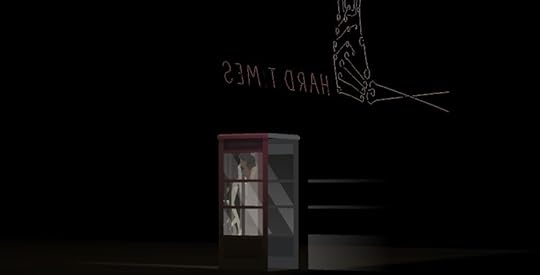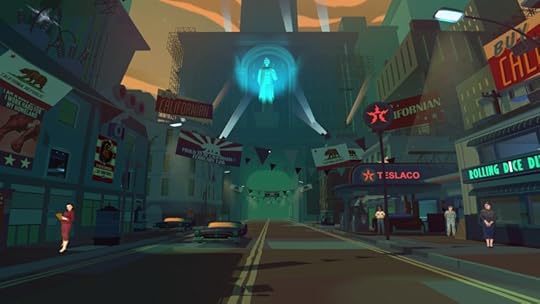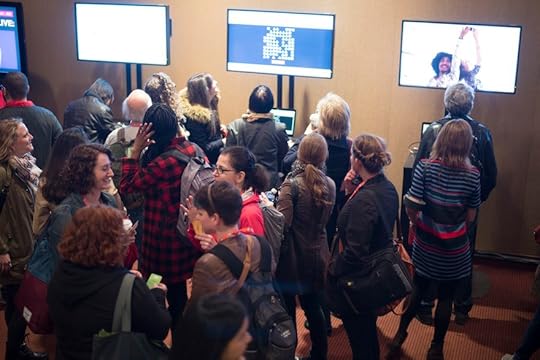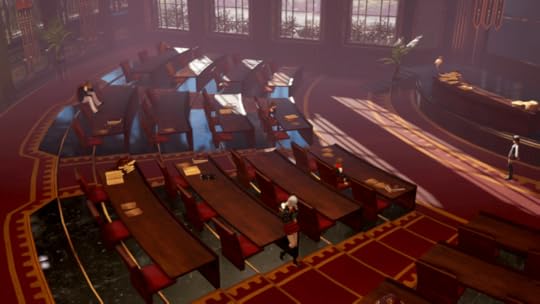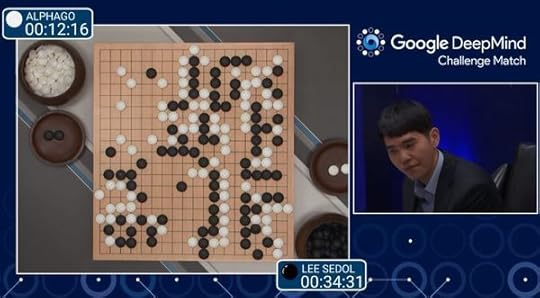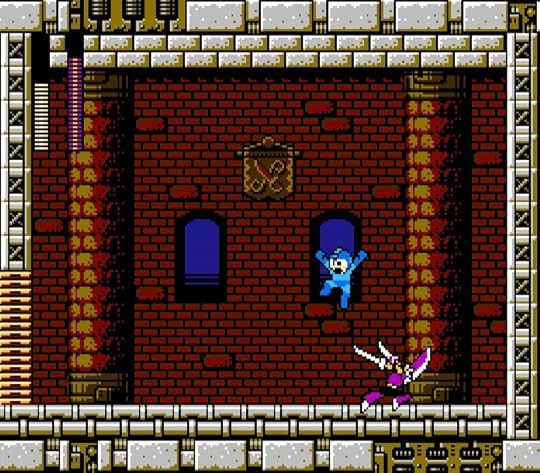Kill Screen Magazine's Blog, page 149
March 15, 2016
Touch & Go: Exploring Alternative Controllers
It’s Sunday afternoon. The exhibit space is in a frenzy. Robin Baumgarten, a London-based game maker, is in Toronto for an exhibit featuring his game, Line Wobbler. As we pass by workers busily preparing the exhibit space, Baumgarten shows me the deceivingly simple-looking controller at the core of his game: a door stopper spring. The inspiration for this unusual controller is a video of a cat playing with a door stopper, using its paw to flick it to and fro. As with that cat, the controller proves to be what fascinates the many exhibit and festival goers wherever the game is shown.
Baumgarten made Line Wobbler back in 2014 alongside Matthias Maschek. It’s become a shining example of the growing interest in games made with custom controllers. These games often combine and re-combine the digital and the physical—creating new forms of playful experiences by mining some of our most mundane habits (such as stacking things or even kissing) to remaking and reusing objects (such as telephone switchboards to quilting machines).
Minimalism and custom-made controllers harken back to the early days of games
Since 2014, the Game Developer’s Conference has recognized this emerging category in games with its own special exhibit called alt.ctrl.GDC, a space dedicated specifically to games with alternative controllers that “challenge traditional forms of input.” Now in its third year, submissions have more than doubled since the exhibit’s creation. This year’s edition features 20 games chosen from a pool of over 140 games submitted. Over at IndieCade, a festival dedicated to independent games, a similar boon is afoot—with submissions of games with nontraditional controllers doubling in the span of one year.
Last year’s alt.ctrl.GDC featured Line Wobbler. “[It] was as much a decorative lighting piece as it was an exercise in minimalism,” says John Polson, co-organizer of alt.ctrl.GDC. Indeed, minimalism is at the core of Line Wobbler, it being played with no more than the door stopper with the player’s actions displayed on a long strip of LED lights. A 1D dungeon crawler, the player wobbles and bends the controller to move her light avatar along the strip— fending off red-tinged enemies and other lighted obstacles. The lighting effects are reminiscent of the moving lights from glow sticks while the explosion of multi-colored lights (when you die) feel like the burst of feedback you get from a casino.
Line Wobbler via Robin Baumgarten
This minimalism and the game’s custom-made controller harkens back to the early days of games. “Alternative controllers, as I consider them, were a staple in our industry since its inception. When you look at Computer Space (1971), Pong (1972), Asteroids (1979), and countless others, their controllers were fascinatingly unique as designers were tackling how we interact with games that now existed in video form,” says Polson.
Arcade games also often experimented with controllers. Mike Lazer-Walker, a Cambridge-based game maker known for Hello Operator (a game made with a vintage telephone switchboard), fondly remembers Konami’s rhythm games like Dance Dance Revolution (1998) and Beatmania (1997) as some of his first encounters with alternative controllers. “I remember being mesmerized by being able to play games by some means other than pressing buttons,” recounts Lazer-Walker.
ROTATOЯ via Robin Baumgarten
Alternative controllers, then, aren’t a new thing. What was once considered a nontraditional or alternative controller can gradually become mainstream and traditional. “Over time, arcade and console controllers generally normalized, but that didn’t stop the inventors from inventing, at any level,” says Polson. This continuous invention led to controllers like the much-maligned Power Glove, released for the NES in 1989, as well as more recent ones like the Oculus Rift.
What has changed over the years is the growing experimentation and production of these controllers by smaller-sized teams. Game makers like Baumgarten and Lazer-Walker function as software creators but also as platform creators. They craft the world of their games but also the very container, a physical object, that allows players to enter these worlds. “Being able to use a controller as a theatrical prop, either to help immerse you in another world or just to help you look like a fool in front of your friends, is incredibly powerful,” explains Lazer-Walker.
These controllers are often one-of-a-kind, never intended to be mass-produced
Making these custom controllers, however, is often accidental. For Sagan Yee, a Toronto-based game maker known for Punk Prism Power (2015)—a game with custom-made weapon controllers—her games tend to include alternative controllers mainly because her friends are part of the larger maker community with access to makerspaces. These places let her and others hack, craft, and tinker using fabrication tools like 3D printers and laser cutters among others. Baumgarten had similar influences: “[My sister] studied industrial design and was actually into these things earlier than me. She introduced me to Arduino. She wasn’t good at programming at first so we combined our efforts — I’d help her with programming and she would do the physical side.”
Like Yee, Baumgarten and other game makers are pulled into experimenting with physical objects and hardware by peers who aren’t necessarily entrenched in the videogame world or focused on screen-based works. What results is often a mix of eclectic projects (from Magical Girl weapons to steering-wheel inspired controllers). Reminiscent of the Art and Crafts movement of the late 1800s, with its emphasis on custom-crafted objects, the maker movement springing up from communities like makerspaces is helping influence game makers to look beyond the digital and into the physical world of custom crafted objects.
Line Wobbler via Robin Baumgarten
Moving into the physical world does not come without its challenges. For a smaller-sized team like the Mahou Shoujammers (the six-person team behind Punk Prism Power), mass producing those Magical Girl weapons would be time-consuming and expensive. Unlike digital games where people can access or share the games through online stores like Steam or itch.io, there is no easy and scalable way to share games with custom-made controllers. More than that, these controllers are often one-of-a-kind, never intended to be mass-produced. But teams like Sensible Object (the group behind the tower stacking game, Fabulous Beast) are paving the way through their experiences in mass producing their own custom-controlled game. It gives us hope that these games and their controllers won’t just be limited to appearances at festivals and conferences.
As these games steer away from traditional controllers (and even screens), some wonder if they are a separate category of games altogether. Celia Pearce, Festival Chair at IndieCade, doesn’t think so: “We are about to enter into a whole new era where the boundaries between games, toys, computers, and board games will be further blurred.”
A week after I chatted with Baumgarten, the exhibit featuring Line Wobbler finally opens. As in the game’s previous showings, curiosity pulls in a crowd. Baumgarten later captures this scene, a typical one for the game, of kids huddled around the game with eyes transfixed to the moving light above them. Speaking of Line Wobbler, Baumgarten echoes IndieCade’s Pearce: “Some people call it a toy. Some people call it a game. But what are games? I don’t really mind what people call it. I’m just happy they’re playing and enjoying it.”
Line Wobbler is on display from March 5 – April 24 at the TIFF digiPlaySpace . ROTATOЯ and Hello Operator will also be featured during this year’s alt.ctrl.GDC from March 14 – 18.
///
Header image: Line Wobbler via Robin Baumgarten
Kentucky Route Zero Act IV gets a mysterious interactive teaser
Oh, it’s coming. Kentucky Route Zero Act IV currently sits out-of-sight—somewhere among the hot haze of a distant horizon—but, rest assured, it is heading this way. No, we don’t have a release date still, but there is yet another teaser to polish with your eyeballs.
Last time, we had only an image. It was static, domestic, mundane. A person leaned on one of the many balconies of a high-rise populated by air-con units and washing that’s been hung out to dry. We don’t know the person in this image. We can only see that they hold a telephone to their ear. Who are they talking to? This new interactive teaser might have the answer. In it, there is a man who is seen talking into the receiver in a phone booth.
Who do you possibly call in such a situation?
That detail is among the least significant in this image. Others raise questions that have our minds travel into that surreal twilight that Kentucky Route Zero so superbly depicts. Take, for starters, the fact that this man’s right arm hangs outside of the phone booth. This is necessary as it appears to have grown two thorny appendages. He dangles his arm rigidly with the extra weight of this alien life form clinging to it. It’s as if a pair of antlers sprouted from his wrist unexpectedly and now he’s on the phone urgently trying to find out what to do next. Who do you possibly call in such a situation? Hopefully Act IV will give us an answer.
The other obvious detail is the neon sign hanging from the brick wall behind the booth. A skeletal hand bends upwards at the wrist to hold a shot glass. “Hard Times,” reads the text next to it. A-ha! Hard Times is the name of the whiskey distillery that has been seen and heard throughout the series. In fact, we visited it in Act III, where Conway was tricked into being indebted to it. And it seems that many residents of game’s version of Kentucky have been similarly duped. It makes sense, then, that Hard Times and its web of debt that connects it to many of Kentucky Route Zero‘s characters should take centerpiece in Act IV. Maybe it will be so.
There is one other detail in this interactive diorama that should not be missed. Spin around the phone booth a little and you should notice that it projects a few streaks of faded white light behind it. What’s significant here is that these streaks of light move through the wall and come out the other side. You might think nothing of it—it looks like a simple mistake. But considering how every tiny detail in Kentucky Route Zero is manufactured with care, and given that the game is all about the unexplained magic and mysteries to be found behind the curtain of daily life, it’s worth paying attention to this. It might be that this is an icon for the game’s magical realism. Or perhaps this is some kind of Bill & Ted-style phone booth that can travel through, if not time, then dimensions. The possibilities multiply.
Get a closer look at this new Kentucky Route Zero teaser in your browser.
Californium can’t get past writer’s block
Growing up in the heyday of graphic adventures has caused me to live in fear of the pixel hunt. It used to be that I’d load up the otherwise innovative Indiana Jones and the Last Crusade (1989) or the visually sumptuous Riven (1997), only to spend hours stuck, madly combing the screen for details that were secretly interactive. I would click every gradient of a stone wall, every book on a library shelf, but nothing would happen. Next screen. Click, nothing. Click. Click, click, click, click. I might cry out expletives in a raspy whisper at the height of my frustration, presuming this to be the work of lazy designers attempting to artificially elongate the play experience—or, worse, sadists who reveled in my gradual demoralization and shame, which would finally bottom out at with a phone call to a 99-cent-per-minute hint line (don’t tell my parents).
This bitter history is why I reacted with such visceral distaste to Californium, an interactive science-fiction story by Franco-German developer ARTE, told across four brief episodes. You play as Elvin Green, a bereaved, bereft writer-who-cannot-write in 1960s Berkeley. After receiving a letter from your wife saying that she is leaving you, a mysterious voice in your head coaxes you to abandon this mess of a life for another, alternate reality. Incidentally, I would like to call a moratorium on games featuring omniscient British men pontificating on the nature of my existence. It worked in The Stanley Parable (2011) but drove me to distraction in Thomas Was Alone (2012)—perhaps enough is enough.
The philosophical take-away is clear: you cannot escape yourself
The narrator’s proposal is undeniably intriguing: there may be a version of you somewhere out in the multiverse who has not made these same destructive choices, for whom things have not gone so wrong. Might you not prefer to jump into his shoes? In practice, however, the premise falls short. Embarking on this wild journey across space and time actually consists of one of the most annoyingly sustained pixel hunts in recent memory.
There are only two ways to interact with Elvin’s world. The first is to walk around a single city block and a few of its buildings (only if the doors are already open, mind you—nothing that corporeally exists can ever be manipulated) and approach static figures standing like cardboard cut-outs in their designated areas: a bum in an alley, a restauranteur in a restaurant, your publisher in his office. When you are near, they will speak about their troubles until they finish or you simply walk away. There is a haunting, intentionally static quality to these interactions, a sense that everyone is as stuck in their miserable lives as Elvin feels stuck in his own. If the game solely consisted of flitting about in a psychedelic haze, hearing blurbs from locals and friends too hung up on themselves to recognize that you are the brink of a total implosion, I might have regarded Californium as an interesting meditation on the limits of control and the artifice of community.
Unfortunately, what you mostly spend your time doing is awkwardly walking around, looking for little glitches in the environment that, when you stand in the right space or view them from the right perspective, become clickable hotspots that begin the process of moving you from your current reality to the next one. It is a maddening exercise, repeated over and over as you pass from Vietnam-era Berkeley to a dystopian world of hyper-patriotism, and eventually on to a Martian colony inhabited by androids. Each time, the philosophical take-away is clear: you cannot escape yourself. Life still sucks—in fact is arguably worse—in each successive reality. That you were unhappy in your original life was not bad luck but something that follows you through each incarnation. And there is nothing to do about it other than listen to people talk and click on to the next dimension.
like a writer banging their head against the desk
Perhaps this underlying thesis is what motivated the creators to make a pixel hunt game in the first place. While my younger self viewed the device as one of laziness or cruelty, it is also possible to see pixel hunting as a direct comment on the illusion of progress in videogames. Locating the icons scattered around Californium moves the story forward, yes, but it is not an accomplishment. It confers no sense of cognitive or motoric mastery, no emotional catharsis. You just click, arbitrarily, on the right thing at the right time. The act of doing so peels back the veneer of one world to show a glimpse of the next, until enough tears in the fabric of space-time exist to facilitate a full transfer. This is “progress,” then: a shifting facade that has no impact on the immutable core. The miserable stay miserable, the lost are lost forever.
Each chapter begins with the current manifestation of Elvin working at his typewriter. Regardless of the reality’s context, he is perpetually struggling to finish something important, to express himself. His entire journey may in fact be regarded as an acid-fueled attempt to cure his writer’s block, which would make Californium as a whole something akin to a creative blockage simulator. This feels an apt description; there are many interesting ideas floating around regarding grief and paranoia, authority and chaos, and how these things will always be a part of our reality no matter how drastically we change the window dressing. It is disappointing that the only way to access these ideas is through the mindless frustration of the pixel hunt, like a writer banging their head against the desk, hoping to dislodge a fundamental truth.
At one point, the game’s narrator takes a break from chiding Elvin’s iterative failures and instead reflects briefly on his own existence. “Am I the grace of god?” he asks, expecting no reply. “Or some form of artificial intelligence? A psychological experiment in which you’re the guinea pig? Am I the manifestation of a temporal epileptic fit affecting your brain? Unfortunately, even I don’t know. I simply deliver my reports.” What makes us who we are, brings us joy or pain, causes the muse to speak through us… all this remains agonizingly obscured. Californium is only here to deliver the report: life is a pixel hunt, and there is no hint line.
For more about Kill Screen’s ratings system and review policy, click here.
March 14, 2016
Finals Fantasy creates game design lesson plans anyone can use
As tablets continue to move into schools and games like Minecraft (2011) are repurposed to educate, the idea of gamification, or using games to teach students about the world, has been gaining popularity as of late. However, as an increasingly diverse artistic medium of its own, others are developing new ways for students to learn about games themselves. Described as a series of “speculative projects for game art students,” Finals Fantasy has gathered together a small group of notable artists, educators, and critics to challenge and expand how game design is taught. (Oh, and so you know, Kill Screen founder Jamin Warren and former Kill Screen intern Nina Freeman are both involved with this project.)
G4C15 Games: Awards Showcase and Arcades at Skirball: General Arcade by Games for Change
Originated by University of Oregon art professor Rick Silva, the project asks various noteworthy figures within videogames to devise a series of lesson plans for students and teachers to use as they please. There are 13 participants in all, including Sunset (2015) co-creator Auriea Harvey, singer and science writer Claire L. Evans, Kentucky Route Zero (2013) co-creator Jake Elliot, and Anne-Marie Schleiner, who has been creating games to comment on issues such as gender and the military since the 1990s, and who currently teaches in the department of communication and new media at the National University of Singapore.
expand how games are taught
Entries range from the more straightforward to the experimental. Schleiner, for instance, asks students to make a three-to-eight minute long game based around the concept of ilinx; or disorientation, irrationality, and dizziness. “Although your game should convey a sense of disorientation to the player,” she explains, “the game should have a structured and defined core play mechanic.” Meanwhile, New York videogame gallery Babycastles takes the pun in the project’s name literally, asking a series of questions prompting students to reconsider longstanding trends in the Final Fantasy series of role playing games. “What if Aeris didn’t die?” they ask. “What if Lifestream smelled bad?”
I think my favorite entry, though, might be from virtual instrument developer Paul Slocum, who simply asks that students make a game with a central goal that is impossible to complete, before demanding “The game shall not be emo, twee, funny, spiritual, or political.”
As computers become more powerful and access to programs like Unity and Game Maker becomes easier, the barrier to entry for making videogames continues to shrink. While college and university programs dedicated to teaching students game design have become more prevalent alongside these advances, there are also an increasing number of developers who are self-taught. As more creators begin to question established trends within games, Finals Fantasy hopes to be a tool for anyone, from any background, asking themselves what exactly a game can be.
You can check out Finals Fantasy’s full lesson plans over on its site.
Just what are we losing to Google’s AlphaGo?
In Tang dynasty China, Go was one of the skills socially required of a certain class of educated elite—along with calligraphy, painting, and the ability to play the stringed guqin, it was part of a kind of artistic quadrivium. The art and beauty of the game are present in the way it is played, but also in descriptions and metaphors for the shapes that appear on the board during play. One of the first shapes shown to new players is the “eye.” If a group of white stones is surrounded by black stones on all sides, it is captured. The same is true if the group has one eye—that is, an empty space inside it—but if it has two separate eyes, any black stone played into one would be captured (the other would stay empty, and the white stones would not be surrounded), and the group of white stones is safe.
This comes naturally out of the rules, and it won’t change because of AlphaGo, but the use of metaphor in Go is extensive. There’s a “bamboo joint,” a “mouth shape,” and a “ladder” structure, too, in which one player chases the other across the board. Traditional wisdom says that the ladder is certain death for the chased player, but apparently this isn’t always the case—in a professional match in 2003, Lee Sedol famously played out a “broken ladder” to his own benefit.
“I don’t really know if it’s a good or bad move.”
Go is a game with a well-established knowledge base that pros occasionally buck with a particularly inspired move, but Google’s AlphaGo program doesn’t have to deal with a thousand years of books and metaphors and mentorship—it learned by playing against itself.
On Wednesday night, in the second of five matches, Google’s AlphaGo beat World Champion Go player Lee Sedol for a second time. His confidence going into the series had waned, and after this second loss, Lee said, “Yesterday, I was surprised, but today, more than that, I’m speechless… there was not a moment in time where I felt that I was leading the game.”
Unable to fit AlphaGo’s moves into familiar patterns, Lee was prohibited from reading his opponent on and off the board. The 37th move of the game, AlphaGo played at space O10. Commentator and professional Go player Michael Redmond noticed the stone, raised an eyebrow, and did a double take. “That’s a very surprising move,” he said, “I don’t really know if it’s a good or bad move.”
Right after AlphaGo played at O10, Lee Sedol left the room for five minutes. When he came back, he spent 10 more minutes scrutinizing the board before playing again. The commentators spent several more minutes describing the move and trying to fit it into a “style” of play, but AlphaGo has been described in turns as “aggressive” and “conservative,” and its moves defy this categorization.
These matches are dramatic in their play, in what they mean for machine learning and artificial intelligence, but also in what they mean for Go. Black 37 in the second game wasn’t the ear-reddening move, and none of these games will take on the ghostly mythology of the blood-vomiting game, but they are part of the long history of Go. As we develop artificial intelligence that doesn’t need metaphors and stories to simplify their data, we may begin to look at our world champions differently and compare our timelines of practice and learning unfavorably to those of these new programs.
For now, take solace in the fact that Sedol was finally able to beat AlphaGo in their fourth match in this best-of-five competition. Not all is lost to the machines yet. The fifth match will be played tomorrow, Tuesday, March 15th.
Header image credit: Photographer Lee Jin-man via Associated Press
The big beards and cute looks of Burly Men at Sea will debut soon
Who says burly can’t be cute? Certainly not David and Brooke Condolora, the husband and wife team that make up Brain & Brain, the brains (ha!) behind Burly Men at Sea, a Scandinavian folklore adventure due out soon on Steam and iOS. Though there’s still no word on an official release date, their newly released trailer serves as a reminder of the soft, minimalistic style and funky character animations that caught our eye in the first place.
David and Brooke Condolora have spoken frequently about the roots of their inspiration. They borrow heavily from scandinavian folklore in both story and style to offer an experience that looks and feels more like a storybook than a game. However, what makes Burly Men at Sea different from the heaps of illustrated books my dad read to me as a kid is that you get to control the path the story takes. Through a frame-shifting mechanic (a slightly more sophisticated cousin to a traditional point-and-click), you get to choose what adventure these bearded characters take through a branching narrative, resulting in a different experience each playthrough. It’s all this that has attracted Indie Fund to invest in the game.
With all its promise of mythology-filled exploration, Burly Men at Sea certainly has the same ingredients of many larger adventure games. But, like Brain & Brain’s previous release Doggins, they’re promising “a quiet adventure.” This time their vision has manifested in cute burly men, who themselves are just as visually offbeat as the premise of their quiet world. “We decided to make games for people like us,” said David Condolora, “People who want a slower, more thoughtful experience.”
You can find out more about Burly Men at Sea on its website.
The wearable tech that’s getting girls into coding
This article is part of a collaboration with iQ by Intel .
Taking friendship bracelets into the digital age, Jewelbots teaches young girls to tinker and code their way into the exploding world of wearable technology.
Whether it’s the Queen of Coding Grace Hopper or the new wave of women innovation engineers, fashion brand CEOs and musicians, young girls today have a growing number of role models who use science, technology, engineering and math (STEM) in their recipes for success.
Having more role models is critical, but according to the founders of Jewelbots—the so-called friendship bracelets for the iPhone era—the next generation of women leaders and inventors will chase STEM endeavors at an early age, like a game of tag.
“Kids want to have fun; it’s their job,” said Brooke Moreland, co-founder of Jewelbots.
These programmable wearables, which are powered by Arduino Gemma microcontrollers, teach girls how to hack hardware and code software so they can customize their own watches.
“The sooner they realize how much fun they can have, the sooner they will be hooked,” Moreland said.
Hooking young girls with hands-on technology could lead them to careers that are underserved by women today. It might even inspire many to start their own STEM-related businesses, like Moreland and Jewelbots co-founder Sara Chipps.
Through Jewelbots, Moreland and Chipps hope to inspire girls to pursue any careers, whether that means programming new video games or studying computer science. Hacking digital bracelets helps girls unlock their own curiosity and potential for becoming leaders in technology and business.
THE SOONER THEY REALIZE HOW MUCH FUN THEY CAN HAVE, THE SOONER THEY WILL BE HOOKED
Chipps is also a developer and co-founder of the non-profit Girl Develop It. She first noticed the importance of empowering young women while teaching them to write software at Flatiron School. Her female students were particularly excited, never realizing what they could do with software until someone took the time to show them.
“Diversity builds a better product and right now software is built by only one demographic,” Chipps said in an interview with AlleyWatch. “Tech is a super-high growth-rate field, and if women don’t focus on tech, they’re not going to be able to get jobs.”
Today, women make up almost half of the total workforce in the U.S. Yet just five years ago, women accounted for only 24 percent of people employed in STEM fields, according to the U.S. Department of Commerce’s Economics and Statistics Administration (ESA).
The ESA points to discrimination and gender stereotyping, a lack of flexible policies for working parents, and the lack of representation and role models for young girls as reasons why women are not as attracted to STEM-related careers.
But women are breaking stereotypes with awareness campaigns like #ILookLikeAnEngineer. They rock the maker movement, create biomimicry-infused garments and provide the tech power behind live music performances.
Companies from small local businesses to global corporations are also committing to workplace diversity.
“Technology and engineering are part of our DNA and we believe a diverse engineering workforce is critical to driving continued innovation and growth in our industry,” said Danielle Brown, who heads up diversity and inclusion at Intel. The company’s $300 million commitment to building a diverse workplace, whose progress is outlined in the 2015 Diversity & Inclusion Report, is paving the way for women and underrepresented minorities.
WE WANT TO EMPOWER THE NEXT GENERATION OF WOMEN
Brown said the skills of a future workforce depend as much on curiosity, creation and design as technical aptitude. To encourage girls’ curiosity and interest in STEM, Brown said Intel will launch a series of activities in 2016 that will include college campus visits, design ideation camps and hackathons designed to connect these young women to role models and career opportunities in STEM.
Moreland said that bringing more women to STEM fields can lead to innovation that’s more diverse and reflects the world’s population.
“Right now, women make up a small percentage of these incredibly important roles,” she said. “We want women’s voices and ideas to be heard, and we want to empower the next generation of women with the skills they need to succeed in this field.”
With more examples like Jewelbots or Cuff and camps like Girls Make Games and Black Girls Code, young girls are getting more opportunities to develop their own technologies to change the world.
Interactive illustrations give pixel art a new lease of life
Pixel art has produced a new trick from up its jagged sleeve—responsive pixel art. Or, as inventive web designer Marcus Blättermann calls it: “resolution-independent pixel illustrations.” Yes, it’s a bit of a mouthful, but don’t worry, interacting with it for the first time should empty your gob as you involuntarily gawp in wonder. It is nothing if not visually spectacular.
You’ll need to head over to Blättermann’s website to play around with the illustrations. There are seven in total (though there’s room to add more), all of which work the same way, just with different images to reveal to you. To explain it, when you open up an illustration you’ll have one of its corners latched to your cursor, letting you increase and decrease the resolution of the image by moving your computer mouse around in any direction. The trick is that that pixel art adjusts in scale to every length and width that you subject it to—make it tall and thin, or a tiny square, or make it fat on all sides; it’ll keep up.
the storytelling potential of this responsive pixel art
However, while this technical feat may be impressive, it’s the storytelling potential of this responsive pixel art that Blättermann only touches upon that gives it true potential. This can be seen in only a few of the adaptive illustrations. Take “Tantalos” for example. It’s based on the Greek myth of Tantalus, in which he is eternally punished by being made to stand underneath an apple tree with low branches that were always just out of reach, and in a pool of water that would recede each time he tried to drink from it. In the pixel art illustration, if you position your cursor to the left of the screen, Tantalus is seen standing as he tries to reach an apple on a tree, and if you drag the cursor to the right he slowly degenerates from a standing to a crawling position, as if your motion fast-forwarded time and he became weaker and more desperate.
The gif of the illustration that you can see above is another example that works well. Called “Zeus,” it tells the tale of the Greek god and his many lovers. Making the image tall and thin shows us the humanoid representation of Zeus, but dragging the image across the screen sees him transform into three different animals: the quail, serpent, and bull. As the myth goes, Asterie was turned into a quail as she scorned Zeus while they were in love, Persephone seduced Zeus as a serpent and the two had intercourse in that form, and Zeus appeared to Europa as a white bull with whom he would have two sons.
How exactly these responsive pixel illustrations work is something that Blättermann plans on detailing soon. Hopefully it’s an idea that will spread and be experimented with as a new tool in interactive storytelling.
You can check out all the pixel illustrations over on Blättermann’s website.
Mega Man, in love and death
I get why Mega Man fans are insatiable. Even after 10 games to the main series’ and at least double that if you include spin-offs and variations, it wasn’t enough for me as a child. I remember browsing the game rack at Bonanza Video and being unable to taper the thirst for more of the series’ Robot Masters. It didn’t matter if I could actually beat any of the Robot Masters, those meat shields made of metal for the nefarious Dr. Wily. I’d have my ass handed to me by every Frog, Skull, and Air Man. I just wanted to see more and more robots themed like an airport restaurant.
I’m not a Mega Boy anymore, who lives a carefree life where school bridged weekend game rentals. I’m a Mega Man, who has to worry about money, worry about tomorrow, and spend a considerable less amount of time concerning myself with what an evil light bulb with eyes and arms would look like. But playing Capcom’s new Mega Man Legacy Collection, having moved passed the Robot Master addiction, makes it easier to see what actually made Mega Man the cornerstone of bygone games.
MEGAMAN: THE CORNERSTONE OF BYGONE GAMES
It’s not about the Robot Masters. It never was. They’re tough, until you clue into their Achilles’ heel—weapons nabbed from other Robot Masters—and then you just need to line them up like dominos. By design they are declawable. I realize now that it’s about all the robots. The big robots and the little robots. The mass produced goons and the mid-level one-offs. It’s about the death traps and the spikes and the left fielders. It’s about all the grievances that’ll bash Mega Man into lil’ scraps like he’s living in the layer of hell closest resembling “Grape Escape” in order to put a stop to Dr. Wily’s umpteenth rampage.
In 2011 Arin Hanson, aka Egoraptor, before becoming the GameGrump phenomen, got the web’s attention with a 20-minute illustrative/sarcastic video on how Mega Man X’s (1993) prologue organically introduces players to X’s new skillset. The video brushes over how the same design tactics were included in the NES games, like seeing the moving platforms that try to dump you towards a certain death in Guts Man’s stage before getting “gotcha’d,” but ultimately floating off to shout about X’s intro. It’s key to acknowledge the culmination of these challenges and how, unlike most games, it isn’t the final boss.
The semiotics of videogame enemies are usually what separates the good games from the iconic. Mario’s foes have some unique quirks but retain obvious visual cues: turtles leave behind shells, ghosts can move through walls, and flat nub-footed mushroom monsters side-step like duende. Mega Man’s foes throw a lot more curveballs. And fireballs. And plasma beams.
For example, the first thing you think of upon encountering a giant blue dog probably isn’t that it’s about to spew a stream of fire that curves upwards, but that’s exactly what a hound in Wood Man’s stage does. There’s a rabbit robot that hops and throws tiny carrot missiles. Sure, there’s a cartoon logic to that. But when a bird drops an egg that doesn’t unleash a single tinier bird but, instead, a swarm of gnat-sized chickadees, that’ll keep you frosty. The Mega Man games are a death trap boy’s Electrical Parade, a steady drip of magical machines each with their own tricks. As Hanson noted, you almost always approach them the first time in some kind of safe environment, a hallway or a distance where their first attack cycle won’t graze you, but it’s where things escalate from there that earns my love.
THE SEMIOTICS OF VIDEO GAME ENEMIES ARE USUALLY WHAT SEPARATES THE GOOD GAMES FROM THE ICONIC
The Battons are one of the most iconic Mega Man goons, appearing in almost every game from Mega Man 2 (1988) onwards. They’re also pushovers, one-hit wonders that lower their defences and swoop down once you are in range. Two are easy. Three are hard. Three is something to worry about. The rate of Mega Man’s fire can’t handle three Battons as gracefully, and what was once just a googly-eyed bat is now a flying deathtrap, assuming they aren’t also accompanying a different deathtrap.
Those spring-a-mabobs, those Mets, those piles of barrels. You can crush them the first time, but the machines are learning, they evolve. They’ll wait for you to jump over spikes or surf flying platforms to nudge you off. They’ll wait for you to climb ladders in narrows. They gang up and learn to drive. Learning their attacks is only the first step, not dying is the next. The Robot Masters have the luxury of only being fought once.
Header image via Flickr.
March 12, 2016
Weekend Reading: Crosswords and Crossed Swords
While we at Kill Screen love to bring you our own crop of game critique and perspective, there are many articles on games, technology, and art around the web that are worth reading and sharing. So that is why this weekly reading list exists, bringing light to some of the articles that have captured our attention, and should also capture yours.
///
A Plagiarism Scandal Is Unfolding In The Crossword World, Oliver Roeder, FiveThirtyEight
A media fiasco is brewing in one of the unlikeliest sections of the paper. Not a Shattered Glass 2 or mere falsifying of information, but plagiarism. Foul foul plagiarism. Revealed is a history of shameless copying since 1999… in the USA Today Crossword. FiveThirtyEight lays out the story of what it even means to copy a puzzle, and how Timothy Parker got busted.
The Quest For The Real-Life Treasures of Atari’s Swordquest, Eric Grundhauser, Atlas Obscura
Speaking of long, niche pursuits, Atlas Obscura digs into one of retro gaming’s best urban legends: a real—real as in, not virtual—golden sword, found only at the end of the Swordquest series’ dweeby labyrinth.
Hulk Hogan Taught Me Never to Make a Bad Joke on Slack Again, Max Read, New York Magazine
You may know about the concerningly surreal trial underway between politics and gossip mega-site Gawker and professional bandanna mannequin Hulk Hogan. Ex-staffer Max Read reflects on how some of his passing jokes about the Hulkster on Slack, the popular work-esque social media service, might have ended up in the proceedings. Read doesn’t so much as damn Slack as much as mourn the watercooler musings it has replaced.
Sasaki Maki’s Magical Mystery Tour, Ceiling Gallery
Described by Osamu Tezuka as “a madman not fit for publication,” Sasaki Maki is one of Japan’s deepest-fried satirists, and with the release of Ding Dong Circus, an anthology, Ceiling Gallery has decided to put together a primer on an artist who in many ways defies primer-ing.
Kill Screen Magazine's Blog
- Kill Screen Magazine's profile
- 4 followers





